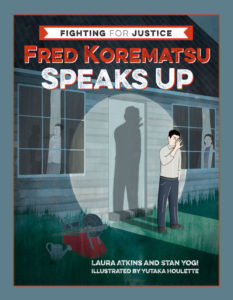Shortly after the Japanese bombing of Pearl Harbor, President Franklin Delano Roosevelt ordered the removal of more than 100,000 Japanese Americans living on the West Coast. From 1942 until the end of the war, men, women, and children lived in bleak internment camps, many of them converted horse stables at former racetracks.
 At the time of the bombing, Fred Korematsu helped his Japanese immigrant parents and U.S. born brothers at the family nursery. He had fallen in love with an Italian American woman, and to keep from being sent to the camp and separated from her, he went into hiding. But he was caught, jailed, and sent to the camp where the rest of his family had already been interned. He decided to sue, and his case went all the way to the Supreme Court – where he lost. Later, when it turned out the evidence for the internment – that Japanese Americans on the West Coast were sending signals to enemy ships – his conviction was overturned.
At the time of the bombing, Fred Korematsu helped his Japanese immigrant parents and U.S. born brothers at the family nursery. He had fallen in love with an Italian American woman, and to keep from being sent to the camp and separated from her, he went into hiding. But he was caught, jailed, and sent to the camp where the rest of his family had already been interned. He decided to sue, and his case went all the way to the Supreme Court – where he lost. Later, when it turned out the evidence for the internment – that Japanese Americans on the West Coast were sending signals to enemy ships – his conviction was overturned.
Through a combination of free verse, informational text, paintings by Japanese American artist Yutaka Houlette, historical photos, and timelines, Laura Atkins and Stan Yogi explore various facets of Korematsu’s story within its broader context of war powers and civil rights. Each chapter begins in verse, capturing Korematsu’s life: encountering prejudice, trying to fit in, falling in love, hiding from a hostile government and populace, hoping for redress within a system that had turned against him and his people, starting over after the war, having his own daughter “discover” his case in school because he never talked about it, and ultimately winning restitution for all Japanese Americans in 1983. The poems are moving and inspiring, and they complement the well chosen and clearly presented historical information. The timeline is an asset, as it hews closely to the theme of each chapter and presents each event or stage in Korematsu’s life in a broader context. For instance, Karen Korematsu finds out about her father’s case during the years of the Civil Rights Movement and farmworkers’ struggles for better pay and working conditions. Throughout, the authors effectively personalize the events, capping each informational section with a question: for instance, “Have you ever felt trapped in a place or situation?” (in the chapter on internment) or “Have you ever learned something about your family that surprised you?” (in the chapter where Karen Korematsu finds out about her father’s case).
Fred Korematsu Speaks Up is the first in the “Fighting for Justice” series published by the venerable California-based small press Heyday Books. It’s a strong series debut than belongs in every elementary and middle school classroom. With rising calls to register and intern religious and other minorities in the United States, this book is now more relevant than ever.
2 comments for “Remembering a Fighter for Justice: A Review of Fred Korematsu Speaks Up”